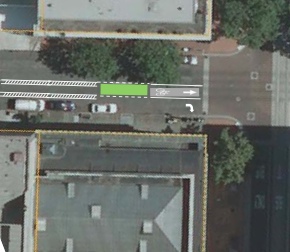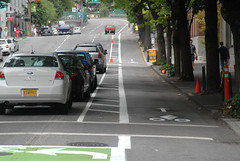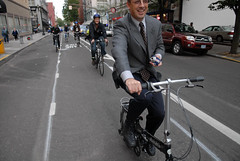Researchers at Portland State University have completed an evaluation of Portland’s cycle track on SW Broadway and buffered bike lanes on SW Stark and Oak. The analysis, prepared for the Portland Bureau of Transportation (PBOT), shows that both of the bikeway types are “working well,” but PSU also laid out some recommendations on how to make them work even better.
Using a combination of road user surveys, video footage, and PBOT data, researchers Chris Monsere, Ph.D. P.E. (Civil & Environmental Engineering), and Nathan McNeil and Jennifer Dill, Ph.D. from the PSU Center for Transportation (the same folks who evaluated the bike boxes for PBOT last fall) compiled detailed information about how the bikeways were being used by people on bikes, on foot, and in cars.
The evaluation has some fascinating nuggets of information:
Cyclists expressed support for the cycle track. Over 70% of survey respondents indicated that the cycle track made cycling on SW Broadway safer and easier… Furthermore, motorists generally disagreed with the sentiment that the cycle track made driving less convenient or that it takes longer to drive this section of SW Broadway now.
Motor vehicle delay is still low after removing one travel lane… PBOT has received few complaints about traffic on SW Broadway (only four traffic-related complaints in the comment log). No issues with parking were identified as a long-term problem.
97% of cyclists are using the cycle track rather than the motor vehicle lanes (prior to the installation of the cycle track, 12% of riders “took the lane” instead of riding in the old bike lane).
Cyclist understanding of and compliance with the traffic signals on SW Broadway is poor… Many cyclists expressed confusion about whether they needed to stop or stay stopped in the cycle track on a red signal indication. Consistent with the survey findings, only 56% of cyclists observed in the video review stopped during the red signal phase (though this is consistent with only 59% of observed cyclists stopped during the red signal before the cycle track was installed). Thus, it is likely that the lack of compliance is related to the lack of conflicting traffic rather than the cycle track design.
Cyclist use of the left-turn boxes could be improved.
Cyclist and pedestrian conflicts are high… Over 40% of cyclists stated they had been involved in a near-collision with a pedestrian, while 12% of pedestrians stated they had been involved in a near-collision with a cyclist.
Loss of curb access presents a challenge to physically handicapped persons.
In a summary, researchers said “overall… the SW Broadway cycle track is working well.” However, they recommend improvements to reduce conflicts between people walking and biking. These include a bike-only traffic signal, a “wait here on red” stencil in the cycle track, improved crosswalk markings, and more.
The researchers also found that the buffered bike lanes on Stark and Oak are “working well.” They also explored two main areas where they could be improved. Since the wide lane looks like a standard vehicle lane, the researchers recommend that PBOT considers additional marking and signage including more bike stencils and overhead lane control signage on traffic signal arms.
Researchers also identified right turns at intersections without a right-turn lane as a “key conflict area.” To remedy that, they recommend creating a right-turn lane by removing some curb parking, shifting the bike lane over, and re-striping in the manner shown below…

New PBOT Director Tom Miller is a proponent of separated bike facilities, so you can bet he’ll use this evaluation to inform decisions in the future. Give it read for yourself by downloading a PDF of the entire report here.
— Researchers Chris Monsere and Nathan McNeil will present this evaluation at a free seminar at PSU tomorrow titled, “Portland’s Cycle Track and Buffered Bike Lanes: Are they working?”



